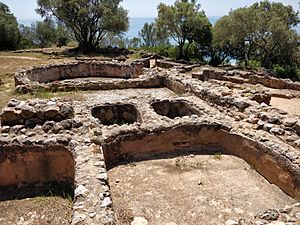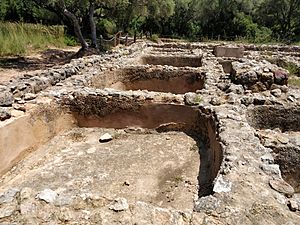Roman ruins of Creiro facts for kids
|
Estação Arqueológica do Creiro
|
|
 |
|
| Location | Serra de Arrábida, Setúbal District, Portugal |
|---|---|
| Coordinates | 38°28′53″N 8°58′36″W / 38.4815022°N 8.9767962°W |
| Type | Ruins from the Roman Empire |
| Site notes | |
| Discovered | 1907 |
| Excavation dates | 1987 |
| Archaeologists | Carlos Tavares da Silva |
| Condition | Fair |
| Public access | Yes |
The Roman ruins of Creiro are ancient buildings from the Roman Empire. You can find them in the Arrábida Natural Park in Portugal, right above Creiro Beach. These ruins were once a factory where people salted fish and also a place with Roman baths.
Contents
History of the Creiro Ruins
Long ago, when the Romans were in charge, the area around the Sado River had lots of fish and salt. This was perfect for making salted fish! Big fish factories grew up in towns like Cetóbriga (today's Setúbal) and Tróia. The Creiro factory was smaller, but it was one of the first places to make salted fish, pickled fish, and special fish sauces. These products were sent all over the Roman Empire! The Setúbal area was super important for Roman fish processing.
An archaeologist named António Inácio Marques da Costa first found these ruins in 1907. But he didn't share much about them. It wasn't until 1964, when his old notes were found, that people really understood what the site was. The first big dig happened in 1987. It was done by the Museum of Archaeology and Ethnology of Setúbal District, led by Carlos Tavares da Silva.
The excavations showed that people lived and worked at this site during three main periods. Within these periods, buildings were changed or added many times.
First Roman Period (1st Century AD)
The first time people lived here was around the middle of the 1st century AD. Most of the factory buildings were built during this time. This included nine tanks for salting and processing fish. These tanks were about 1 to 2.6 meters wide and 0.5 to 1 meter deep. To stop leaks, the tanks were lined with a special waterproof plaster called opus signinum. The corners of the tanks were rounded, which made them easier to clean and keep hygienic.
During this period, they also built warehouses to store things. There was a house for the owner and possibly homes for the workers too. They also had a well for fresh water, which was lucky because there aren't many springs nearby. There was also a large water tank called a cistern.
Heated Roman baths were also built at this time. These baths used a clever heating system called a hypocaust. A furnace in the basement heated air, which then flowed under the floor of the bathhouse. This made the floors and rooms, especially the hot room (called the caldarium), warm. You can still see some pillars that held up the floor where the hot air moved. You can also see the cold room (called the frigidarium), which was covered in marble.
Towards the end of the 1st century AD, during this first period, they added two new tanks to the fish factory. These new tanks were not as deep and let more water through. Archaeologists think these were used to store salt or fish, not for making sauces.
Second Roman Period (4th Century AD)
The first period of use ended around the late 1st century AD. The site then seemed empty for a long time, until the middle of the 4th century. During this second period, people mainly repaired the old buildings so they could start processing fish again. They didn't use the best building materials this time. This was common as the Roman Empire started to decline. They even reused some materials from the earlier buildings. They also improved how rainwater and factory waste drained away.
The Romans stopped using the Creiro complex around the end of the 4th century AD or the beginning of the 5th century.
Later Occupation (12th Century)
The third time people lived at the site was much later, in the 12th century. This was during the Almohad period, when Muslims ruled parts of Portugal (known as Al-Andalus at the time).
See also
 In Spanish: Ruinas romanas de Creiro para niños
In Spanish: Ruinas romanas de Creiro para niños


